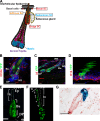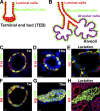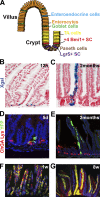Tracing epithelial stem cells during development, homeostasis, and repair
- PMID: 22641343
- PMCID: PMC3365500
- DOI: 10.1083/jcb.201201041
Tracing epithelial stem cells during development, homeostasis, and repair
Abstract
Epithelia ensure many critical functions of the body, including protection against the external environment, nutrition, respiration, and reproduction. Stem cells (SCs) located in the various epithelia ensure the homeostasis and repair of these tissues throughout the lifetime of the animal. Genetic lineage tracing in mice has allowed the labeling of SCs and their progeny. This technique has been instrumental in characterizing the origin and heterogeneity of epithelial SCs, their tissue location, and their differentiation potential under physiological conditions and during tissue regeneration.
Figures




Similar articles
-
Lineage-Restricted Mammary Stem Cells Sustain the Development, Homeostasis, and Regeneration of the Estrogen Receptor Positive Lineage.Cell Rep. 2017 Aug 15;20(7):1525-1532. doi: 10.1016/j.celrep.2017.07.066. Cell Rep. 2017. PMID: 28813665 Free PMC article.
-
Bipotent stem cells support the cyclical regeneration of endometrial epithelium of the murine uterus.Proc Natl Acad Sci U S A. 2019 Apr 2;116(14):6848-6857. doi: 10.1073/pnas.1814597116. Epub 2019 Mar 14. Proc Natl Acad Sci U S A. 2019. PMID: 30872480 Free PMC article.
-
Plasticity within stem cell hierarchies in mammalian epithelia.Trends Cell Biol. 2015 Feb;25(2):100-8. doi: 10.1016/j.tcb.2014.09.003. Epub 2014 Oct 9. Trends Cell Biol. 2015. PMID: 25308311 Review.
-
Lineage enforcement by inductive mesenchyme on adult epithelial stem cells across developmental germ layers.Stem Cells. 2009 Dec;27(12):3032-42. doi: 10.1002/stem.244. Stem Cells. 2009. PMID: 19862839
-
Hippo signaling in epithelial stem cells.Acta Biochim Biophys Sin (Shanghai). 2015 Jan;47(1):39-45. doi: 10.1093/abbs/gmu111. Epub 2014 Dec 4. Acta Biochim Biophys Sin (Shanghai). 2015. PMID: 25476205 Review.
Cited by
-
Cancer stem cell definitions and terminology: the devil is in the details.Nat Rev Cancer. 2012 Nov;12(11):767-75. doi: 10.1038/nrc3368. Epub 2012 Oct 11. Nat Rev Cancer. 2012. PMID: 23051844 Review.
-
Unravelling cancer stem cell potential.Nat Rev Cancer. 2013 Oct;13(10):727-38. doi: 10.1038/nrc3597. Nat Rev Cancer. 2013. PMID: 24060864 Review.
-
Spatial organization within a niche as a determinant of stem-cell fate.Nature. 2013 Oct 24;502(7472):513-8. doi: 10.1038/nature12602. Epub 2013 Oct 6. Nature. 2013. PMID: 24097351 Free PMC article.
-
Generation of Spheres from Dental Epithelial Stem Cells.Front Physiol. 2017 Jan 19;8:7. doi: 10.3389/fphys.2017.00007. eCollection 2017. Front Physiol. 2017. PMID: 28154538 Free PMC article.
-
Cancer stem cells: biological functions and therapeutically targeting.Int J Mol Sci. 2014 May 9;15(5):8169-85. doi: 10.3390/ijms15058169. Int J Mol Sci. 2014. PMID: 24821540 Free PMC article. Review.
References
-
- Adamson I.Y., Bowden D.H. 1975. Derivation of type 1 epithelium from type 2 cells in the developing rat lung. Lab. Invest. 32:736–745 - PubMed
-
- Barker N., Huch M., Kujala P., van de Wetering M., Snippert H.J., van Es J.H., Sato T., Stange D.E., Begthel H., van den Born M., et al. 2010b. Lgr5(+ve) stem cells drive self-renewal in the stomach and build long-lived gastric units in vitro. Cell Stem Cell. 6:25–36 10.1016/j.stem.2009.11.013 - DOI - PubMed
Publication types
MeSH terms
LinkOut - more resources
Full Text Sources
Medical

